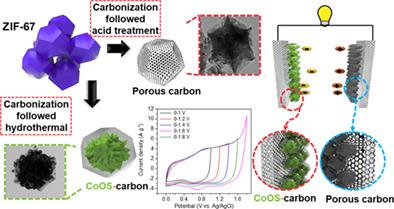当前位置:
X-MOL 学术
›
Int. J. Energy Res.
›
论文详情
Our official English website, www.x-mol.net, welcomes your
feedback! (Note: you will need to create a separate account there.)
Metal‐organic framework‐derived carbon‐cobalt oxysulfide nanocage heterostructure electrode for efficient hybrid supercapacitors
International Journal of Energy Research ( IF 4.3 ) Pub Date : 2020-11-25 , DOI: 10.1002/er.6218 Kugalur Shanmugam Ranjith 1 , Ganji Seeta Rama Raju 1 , Cheol Hwan Kwak 2, 3 , Seyed Majid Ghoreishian 3 , Yun Suk Huh 3 , Ji Sun Im 2, 4 , Young‐Kyu Han 1
International Journal of Energy Research ( IF 4.3 ) Pub Date : 2020-11-25 , DOI: 10.1002/er.6218 Kugalur Shanmugam Ranjith 1 , Ganji Seeta Rama Raju 1 , Cheol Hwan Kwak 2, 3 , Seyed Majid Ghoreishian 3 , Yun Suk Huh 3 , Ji Sun Im 2, 4 , Young‐Kyu Han 1
Affiliation

|
Construction of hybrid supercapacitors (HSCs) with defect engineered electrodes derived from single metal‐organic frameworks (zeolitic imidazolate frameworks, ZIF‐67) via control of the thermal influences showed unique structural features and rich electrochemical properties. Designing the three‐dimensional Co oxysulfide nanograins with carbon frame (CoOS‐C)‐based positive electrode surfaces through sulfidation with tunable defect states along with N‐ and S‐doping states improved the electrical energy storage; further, the possibility of having a carbon‐based skeleton surface influenced the effective rate capability during the charge‐discharge process. This unique nanostructural feature with encapsulation of porous N‐ and S‐doped graphitic carbon enabled improved rate performance by enhancing the stability of the electrode material and shortening the ion‐diffusion paths by the synergistic effect. Owing to the tunable defect functionality, the CoOS‐C based electrode exhibited a high storage capacity of 708.8 C g−1 at 1 A g−1 and an excellent rate capability with long‐term cyclic stability, with more than 93% capacity retention after 3000 cycles. Furthermore, the fabricated HSCs operated within a wide potential window of 1 to 1.6 V, which allowed excellent rate capability with a high‐energy density of 31.7 W h kg−1 at a specific power density of 800 W kg−1 with long‐term cyclic stability up to 10 000 cycles.
中文翻译:

金属有机骨架衍生的碳钴氧硫化碳纳米笼型异质结构电极,用于高效混合超级电容器
通过控制热影响,利用由单个金属有机骨架(沸石咪唑酸酯骨架,ZIF-67)衍生的缺陷工程电极构建混合超级电容器(HSC),显示出独特的结构特征和丰富的电化学性能。通过具有可调整缺陷状态以及N和S掺杂状态的硫化作用,设计具有碳框架(CoOS-C)基正电极表面的三维含氧硫化碳纳米颗粒,从而改善了电能存储;此外,碳基骨架表面的可能性会影响充放电过程中的有效倍率能力。这种独特的纳米结构特征与多孔的N和S掺杂的石墨碳一起封装,通过增强电极材料的稳定性并通过协同效应缩短了离子扩散路径,从而提高了速率性能。由于可调节的缺陷功能,基于CoOS‐C的电极具有708.8 C g的高存储容量-1 1 A G -1和3000次循环后优异的倍率性能长期循环稳定性,有超过93%的容量保持率。此外,所制造的HSC在1至1.6 V的宽电势窗口内工作,从而具有出色的速率能力,可在800 W kg -1的比功率密度下长期以31.7 W h kg -1的高能量密度进行长期工作。循环稳定性高达10000次循环。
更新日期:2020-11-25
中文翻译:

金属有机骨架衍生的碳钴氧硫化碳纳米笼型异质结构电极,用于高效混合超级电容器
通过控制热影响,利用由单个金属有机骨架(沸石咪唑酸酯骨架,ZIF-67)衍生的缺陷工程电极构建混合超级电容器(HSC),显示出独特的结构特征和丰富的电化学性能。通过具有可调整缺陷状态以及N和S掺杂状态的硫化作用,设计具有碳框架(CoOS-C)基正电极表面的三维含氧硫化碳纳米颗粒,从而改善了电能存储;此外,碳基骨架表面的可能性会影响充放电过程中的有效倍率能力。这种独特的纳米结构特征与多孔的N和S掺杂的石墨碳一起封装,通过增强电极材料的稳定性并通过协同效应缩短了离子扩散路径,从而提高了速率性能。由于可调节的缺陷功能,基于CoOS‐C的电极具有708.8 C g的高存储容量-1 1 A G -1和3000次循环后优异的倍率性能长期循环稳定性,有超过93%的容量保持率。此外,所制造的HSC在1至1.6 V的宽电势窗口内工作,从而具有出色的速率能力,可在800 W kg -1的比功率密度下长期以31.7 W h kg -1的高能量密度进行长期工作。循环稳定性高达10000次循环。











































 京公网安备 11010802027423号
京公网安备 11010802027423号